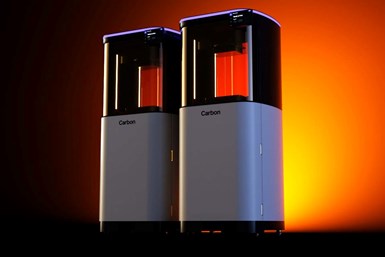Carbon’s M3, M3 Max Designed for Faster, Larger, Smoother DLS Printing
The new generation of 3D printers is said to bring faster printing, larger build volume and new capabilities to the Carbon Digital Light Synthesis (DLS) platform.
Share
Read Next

The M3 and M3 Max DLS printing is said to create substantially lower forces on the part and introduces closed-loop control of force and temperature to reduce failure modes and simplify the print experience. Photo Credit: Carbon
Carbon’s M3 and M3 Max DLS printers are said to provide an advanced end-to-end, idea-to-production platform when combined with Carbon’s Design Engine and DLS materials. The M3 is designed for faster printing, simpler print experience, expanded design space and more consistent surface finish. The M3 Max offers the same benefits as well as a 4K light engine to enable double the build area with the same pixel size and density.
The company says the M series works with a wide range of high-performance materials tailored for applications across industries such as automotive, life sciences, dental, consumer products and industrial. The printers are said to enable design teams to create high-quality prototypes with end-use performance quicker and more efficiently. And, once product development is complete, this platform is said to enable companies to move to production quickly and efficiently anywhere in the world.
The DLS printing is said to create substantially lower forces on the part and introduces closed-loop control of force and temperature to reduce failure modes and simplify the print experience. The printers also offer a broader design space, making parts that prior generations could not and unlocking more geometries (especially for elastomeric parts) or parts with features most sensitive to high forces.
Both printers enable faster printing thanks to better heat management, delivering more throughput per square foot in thermally limited scenarios, the company says. The printers are also said to produce smoother parts than prior generations. Parts are also more consistent parts as the printers are said to reduce the variation in parts across a single build by up to 50% — translating to less variation in general accuracy and more production repeatability in engineering resins.
According to the company, installion is fast and easy with the M3 installed in hours, with the ability to relocate the printer within facilities as customers see fit. The M3 Max features a larger build area, offering double the build area with the same pixel size and density as the M3 printer, making it well suited for larger parts or producing many smaller parts with similar quality.
Related Content
-
8 Cool Parts From RAPID+TCT 2022: The Cool Parts Show #46
AM parts for applications from automotive to aircraft to furniture, in materials including ceramic, foam, metal and copper-coated polymer.
-
How to Build 10,000+ Shot Molds in Hours
Rapid tooling isn’t so rapid when it takes days to 3D print a metal mold, and then you still must machine it to reach the necessary tolerances. With Nexa3D’s polymer process you can print a mold in hours that is prototype or production ready and can last for more than 10,000 shots.
-
Possibilities From Electroplating 3D Printed Plastic Parts
Adding layers of nickel or copper to 3D printed polymer can impart desired properties such as electrical conductivity, EMI shielding, abrasion resistance and improved strength — approaching and even exceeding 3D printed metal, according to RePliForm.








.png;maxWidth=300;quality=90)





